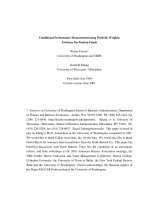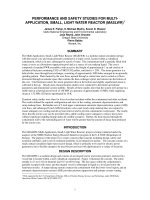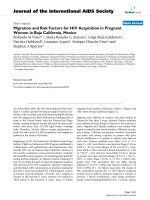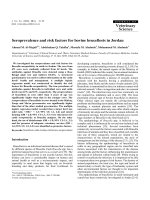Chapter 3 performance and risk measurement for pension funds
Bạn đang xem bản rút gọn của tài liệu. Xem và tải ngay bản đầy đủ của tài liệu tại đây (3.46 MB, 14 trang )
CHAPTER
3
Performance and
Risk Measurement
for Pension Funds
Auke Plantinga
CONTENTS
3.1 I ntroduction
3.2 Liability-Driven Investing and Pension Liabilities
3.3 Liability-Driven Risk and Performance Attribution
3.3.1 P erformance Measure
3.3.2 R isk Measures
3.3.3 B enchmark
3.3.4 P erformance Attribution
3.4 An Application of the Model
3.5 Conclusion and Discussion
References 8
72
72
76
76
76
77
78
80
83
4
T
his ch a pter p r opos es a n a ttribution m odel f or m onitoring t he
performance and risk of a defined benefit pension fund. In order to
facilitate easy interpretation of the results, the return is expressed as a
percentage of the value of the liabilities. The model is based on a liability
benchmark t hat re flects t he r isk a nd return cha racteristics of l iabilities.
As a r esult, t he a ttribution m odel f ocuses t he a ttention o f t he po rtfolio
managers on creating a portfolio that replicates liabilities. The attribution
model allocates differences in return between the actual and benchmark
portfolio to decisions relative to the benchmark portfolio. In addition, the
model decomposes risks according to the same structure by using a measure of downside risk.
71
© 2010 by Taylor and Francis Group, LLC
72 ◾ Pension Fund Risk Management: Financial and Actuarial Modeling
3.1 INTRODUCTION
Pension funds around the world suffered dramatically from falling stock
markets in the period 1999–2003 as well as during the current 2008–2009
financial crisis. Many pension funds have become underfunded, and face
funding ratios well below 100%. In both periods, stock markets performed
badly a nd i nterest r ates d ropped considerably. These a re conditions t hat
have a ser ious impact on pension f und ba lance sheets, by decreasing t he
market value of the assets and increasing the market or fair value of the liabilities. Ryan and Fabozzi (2002) provide evidence of the existence of large
mismatches between assets and liabilities in the 200 largest U.S. definedbenefit plans prior to the first pension crisis. For example, in 1995 the assets
of these 200 pension funds yielded an average positive return of 28.70%,
which was insufficient to match with the liability return of 41.16%.
Liability-driven in vesting i s a n in vestment p hilosophy t hat im plies
managing a ssets r elative t o l iabilities.* W ith l iability-driven i nvesting,
pension f unds c an reduce t heir ex posure to financial crises by reducing
the mismatches between assets and liabilities.
In order to encourage pension funds to adopt liability-driven investment
strategies, i t i s n ecessary t o r edesign per formance a nd r isk m easurement
systems. The best way to accomplish this is by adopting a so-called liabilitydriven benchmark for performance and risk management.
In this study, we discuss a performance and risk measurement system
that f ocuses o n l iability-driven i nvesting. W ithout a ppropriate per formance and risk measurement, liability-driven investing will be difficult
to manage as portfolio managers will be tempted to focus on traditional
asset-only benchmarks. We propose a number of new elements in measuring per formance a nd r isk for pension f unds. The first new element
is by measuring the performance of a pension fund relative to the value
of the liabilities in order to focus on the societal objective of a pens ion
fund as the provider of reliable pensions. The second new element is that
we propose to use a decomposition of downside risk consistent with the
decomposition of performance.
3.2 LIABILITY-DRIVEN INVESTING AND PENSION LIABILITIES
Liability-driven investing is a strategy aimed at reducing a pension plan’s
risks by choosing assets that serve as a hedge for the risks implicit in the
liabilities. This i s o nly pos sible f or a l imited se t o f r isk fac tors t hat a re
* See, for example, Leibowitz (1986), Siegel and Waring (2004), and Waring (2004).
© 2010 by Taylor and Francis Group, LLC
Performance and Risk Measurement for Pension Funds ◾ 73
present bo th i n t he a sset po rtfolio a nd t he l iability po rtfolio. The most
important of these risks are the interest rate risk and the inflation risk.*
Some other risks in the liability portfolio are difficult to hedge with traditional a sset cla sses, such a s t he mortality r isk or t he operational r isk.
Those types of risks can be reduced by, for example, reinsurance, or simply
by creating an a dditional s olvency buffer f or u nexpected l osses. I n t his
study, we implement liability-driven investing using cash flow matching.
Cash flow matching is a robust strategy for dealing with any type of term
structure movement. Practical considerations may result in choosing for a
less robust solution, such as duration matching.
Pension claims in a defined-benefit plan are largely determined by the
wages earned by the beneficiaries and the number of years of employment.
With a final pay system, the pension claims are based on the wage earned
in the last year. However, it is also common to have claims as a function
of past wages earned, such a s t he average wage earned during t he years
of em ployment. A co rrect va luation o f t he l iabilities i s c rucial i n ma naging pens ion f unds. The va lue o f l iabilities ser ves a s a ben chmark f or
the level of assets needed to ser vice the future cash flows of the pension
fund. The valuation starts with an appropriate estimate of the future cash
flows resulting from the current promises made to beneficiaries. Next, the
present value of these cash flows is calculated using a d iscount rate. This
discount rate is a c rucial element i n t he l iability-driven benchmark. We
propose to use the risk-free rate on government bonds as the discount rate.
In combination with a matching strategy and sufficient assets, this means
that the liabilities will be met with certainty.† From the perspective of the
beneficiary, a va luation ba sed on t he r isk-free government bond r ates is
the preferred alternative since it provides the opportunity to create riskless pension claims. It is important to see that the resulting value is not the
market value of the liabilities, but the value of a risk-free cash flow desired
by the beneficiaries. If the present value of the liabilities based on government bond r ates exceeds t he va lue of t he a ssets, it i s clear t hat t he t rue
market value of the liabilities is less, unless the sponsor provides a credible
guarantee to make up for any deficits.
The return on the cash flow matching strategy is the minimum acceptable return (MAR) to be achieved on the assets (see Sortino et al., 1999).
If the assets do not yield this return, the future pension benefits cannot be
* Another factor is currency risk, which we ignore in this chapter by assuming that the pension
fund has single currency pension liabilities.
† The conditions for creating an immunized portfolio are specified by Redington (1952).
© 2010 by Taylor and Francis Group, LLC
74 ◾ Pension Fund Risk Management: Financial and Actuarial Modeling
realized without further sponsor contributions. The actual realization of
reliable pensions depends on the investment strategy. In order to keep the
focus of portfolio managers on the objective of the pension beneficiaries,
the cash flow matching strategy, which gives the best chance of realizing
the objective, has to be embedded in the asset benchmark.
Elton and Gruber (1992) provide a t heoretical justification for the use
of matching strategies in the context of a mean–variance framework. For
a pension fund with assets A and present value of liabilities L, the return
on surplus is
rs =
St +1
A(1 + ra ) − L(1 + rl )
−1 =
−1
St
A−L
(3.1)
The r iskless st rategy, F, is to invest an amount, L, i n a po rtfolio of c ash
flow–matched a ssets, a nd t o i nvest t he r emainder i n t reasury b ills. The
return of this strategy is
rF =
( A − L)(1 + rf ) + (L − L)(1 + rl )
− 1 = rf
A−L
(3.2)
Similarly, the return on a risky strategy R is
rR =
A(1 + rR ) − L(1 + rl )
L
− 1 = rR + (rR − rl )
A−L
S
(3.3)
Any co mbination o f t hese t wo po rtfolios r esults i n a po rtfolio o n a
straight l ine connecting F and R i n t he mean st andard de viation space,
similar to the capital market line in the CAPM. However, the underlying
portfolios are different and depend on the leverage and liability returns.
Consequently, different investors have opportunity sets. The actual choice
for an asset portfolio depends on the risk aversion of the pension fund.
Pension funds have a multitude of participants that also have different
interests. Therefore, t he q uestion h ow t o ch oose a l evel o f r isk a version
for the pension fund that is representative for all participants is not easy
and perhaps even impossible to answer. In many of the surplus optimization models, the surplus is owned by the plan sponsor, and the criterion
for choosing an asset portfolio is to maximize the utility of the surplus.*
As stated by Erza (1991): “A defined benefit pension plan is effectively an
operating d ivision o f t he spo nsor.” W ith pens ion f unds bei ng o perating
divisions of sponsors, conflicts of interest with the beneficiaries may arise.
* See, for example, Elton and Gruber (1992), Erza (1991), or Sharpe and Tint (1992).
© 2010 by Taylor and Francis Group, LLC
Performance and Risk Measurement for Pension Funds ◾ 75
Beneficiaries have a d ifferent perception o f r isk. From a ben eficiary’s
point of view, any asset portfolio is risk-free as long as the pension fund
allocates an amount Al ≥ L to a cash flow–matched portfolio. In addition,
the st rategy for t he su rplus a ssets As should return above t he t hreshold
level −As/S. If returns on the surplus asset are below the threshold value,
the surplus assets become negative and this decreases the value of liabilitydriven in vestments. B eneficiaries ha ve o nly l imited i nterest i n r eturns
above that required to service liabilities, since they usually do not share in
the surplus returns.
The different perspec tives on r isk by t he sponsor a nd t he beneficiaries
motivate a d istinction be tween su rplus a ssets a nd l iability-driven a ssets.
As long as the sponsor is willing to choose an asset portfolio that is risk-free
from t he perspec tive of t he beneficiaries, t he potential conflict of i nterest
is not relevant. By separating the assets in two portfolios, one dedicated to
liability-driven investments and one to surplus-driven investments, the participants can easily monitor the value of the portfolio dedicated to service
their claims. Participants or their representatives should be able to observe
whether large differences exist between the value of liabilities and liabilitydriven a sset portfolios. If la rge d ifferences do ex ist, t his is a sign t hat t he
fund has potentially a la rge exposure to risk. In combination w ith a r iskmonitoring system, this safeguards the continuity of the pension fund.
In constructing a liability-driven investment portfolio, it is important to
make a distinction between nominal and real liabilities. The liabilities of pension funds can be nominal, real, or a mixture of nominal and real. Nominal
liabilities are promises to pay future cash flows expressed in nominal terms.
Real liabilities are promises to pay future cash flows with a fixed purchasing
power. Each type of liability should be matched with the appropriate type of
asset. Nominal liabilities can be matched with nominal government bonds
and real liabilities can be matched with inflation-linked bonds such as TIPS.
Since each type of liability requires a different type of instrument, it is convenient to create separate asset portfolios for each type of liability.
We use cash flow matching as the strategy to construct the benchmark.
In practice, duration matching and other factor immunization strategies
are f requently u sed a s a n a lternative f or r easons o f flexibility. Duration
matching opens t he possibility to create a ma tched portfolio even i f t he
sum of the maturities of the liability cash flows exceed the largest available asset maturity. However, matching based on duration may not shield
against c ertain n onparallel s hifts o f t he ter m st ructure. Ther efore, we
believe t hat i n co nstructing t he ben chmark, c ash flow matching is the
best alternative as it provides the best track of the value of the liabilities.
© 2010 by Taylor and Francis Group, LLC
76 ◾ Pension Fund Risk Management: Financial and Actuarial Modeling
Duration matching can be used to create the actual asset portfolio. As a
result, de viations be tween t he r eturn of t he duration a nd t he c ash flow
matching strategy are measured in the performance attribution model.
3.3 LIABILITY-DRIVEN RISK AND PERFORMANCE
ATTRIBUTION
In developing benchmarks and a performance attribution model, we value
the assets based on their market values, and the liabilities as the present
value of the expected cash flows using the nominal- and real-term structures of interest rates. This results in the following stylized balance sheet:
Assets
Surplus assets
Nominal assets
Real assets
Liabilities
As
Anl
Arl
Surplus
Nominal liabilities
Real liabilities
S
Ln
Lr
Managing the performance and risk of pension fund assets relative to its
liabilities ha s i mplications f or t he per formance a nd r isk m easures, t he
benchmark and the attribution model.
3.3.1 Performance Measure
The performance measure should be chosen consistent with the objective
of the pension fund in mind. The main objective of a pens ion fund is to
provide ben efits to its members. This suggests that we should focus on
measuring the performance from the perspective of the liabilities. We propose to measure the performance by scaling the changes in surplus by the
liability value as opposed to scaling by assets or scaling by surplus. From
a mathematical point of view, scaling is irrelevant for the decomposition.
However, the major advantage of scaling by liability value is that losses are
expressed in terms of liability value, so beneficiaries can directly relate to
the magnitude of losses. A l oss of 10% for an underfunded pension plan
implies that, roughly speaking, a beneficiary is likely to receive 10% less in
pension payments.* This measure of pension fund performance is closely
related to the funding ratio return proposed by Leibowitz et al. (1994).
3.3.2 Risk Measures
Since the sponsor and the beneficiaries have different perspectives on risk,
it makes sense to use two risk measures. The difference in asset and liability
* This is different from the surplus approach proposed by Ezra (1991) and Sharpe and Tint (1990).
© 2010 by Taylor and Francis Group, LLC
Performance and Risk Measurement for Pension Funds ◾ 77
returns is a general measure of risk, as it focuses on changes in the value of
surplus. This measure is relevant for both parties involved in the pension
fund. We use a d ownside risk measure as suggested by Sortino and Van
der Meer (1991) i n order to accommodate de viations f rom normality i n
the return distribution. The downside risk measure is calculated based on
a simulated distribution of possible outcomes:
2
n
DR =
∑
x =1
⎛ ∆S
⎞
ιx ⎜ x − rmar ⎟
⎝ L
⎠
n
(3
.4)
where
ιx is a dummy variable with value 1 for all ∆Sx/L < rmar
∆Sx/L is the change in surplus in simulation run x scaled by liability value
rmar = 0
n is the number of simulation runs
If the surplus return is negative, asset returns are lower than liability returns.
Beneficiaries a re ma inly co ncerned w ith l osses a s fa r a s t hey dec rease
the value of their benefits. This motivates a second downside risk measure,
based on a more conservative minimal acceptable rate of return:
rmar* = −
S
(3
L
.5)
which i s t he t hreshold r eturn t hat d ifferentiates b etween en ding w ith a
positive or a negative surplus value.
In calculating downside risk measures, we need a distribution of asset
and liability returns. Using historical numbers is not very meaningful in
constructing such a d istribution since the nature of assets and liabilities
may change over time. Therefore, we use a simulation model in the spirit
of the value-at-risk models used in banking. There is a va st literature on
how t o c reate such m odels, wh ich i s be yond t he scope of t his st udy. At
this point, it suffices to state that the measures are calculated over the outcomes of the different simulation runs.
3.3.3 Benchmark
The benchmark for the pension fund is a weighted average of the benchmark return for the surplus investments and the two groups of liabilitydriven investments (Table 3.1).
© 2010 by Taylor and Francis Group, LLC
78 ◾ Pension Fund Risk Management: Financial and Actuarial Modeling
TABLE 3.1
Benchmark Composition and Return
Portfolio
Surplus-driven assets
Benchmark Weight
Benchmark Return
p
s
Nominal liability-driven
assets
Real liability-driven assets
w = S/A
rsp
wnlp = Ln /A
rnlp
wrlp = Lr /A
rrlp
The benchmarks for the liability-driven assets are based on replicating
the return and risk of the liabilities. Given that defined-benefit pensions
are fi xed in terms of nominal or real benefit, we use portfolios of bonds
that are cash flow–matched with the liabilities. The return on the portfolio matched with the nominal liability is rnlp, and the return on the portfolio
matched with the real liabilities is rrlp.
3.3.4 Performance Attribution
The ba sis for t he per formance attribution model is t he benchmark spec ified abo ve i n co njunction w ith t he dec ision p rocess w ithin t he pens ion
fund. C onsistent w ith our portfolio a nd benchmark st ructure, we d istinguish between active decisions within one of the asset portfolios and active
decision with respect to the allocation to each of the asset portfolios. Active
decisions w ithin one of t he asset portfolios refer to t he decision to have a
portfolio with a different composition as compared to the benchmark. For
the surplus-driven assets, this could be the decision to invest in an actively
managed fund. For the liability-driven assets, this is the decision to invest
in, for example, bonds with different maturities or to i nvest in bonds with
a d ifferent c redit qu ality. The a llocation m ismatches a re t he de viations
between the market value of the asset portfolios and the value of the liability portfolios that they aim to cover. In Table 3.2, we summarize the main
sources of return. We express the active return and the return on allocation
mismatches in terms of our proposed performance measure.
TABLE 3.2 Decision Process
Surplus-driven
assets
Liability-driven
nominal assets
Liability-driven
real assets
Allocation
mismatches
Actual Return
Benchmark Return
Active Return
r as
r ps
[rsa − rsp ]S/L
rnla
rnlp
[rnla − rnlp ]Ln /L
rrla
rrlp
[rrla − rrlp ]Lr /L
[( As − S)rsa + ( An − Ln )rnla + ( Ar − Lr )rrla ]/L
© 2010 by Taylor and Francis Group, LLC
Performance and Risk Measurement for Pension Funds ◾ 79
We construct a performance attribution model by analyzing the incremental i mpact of i ndividual d ecisions on b enchmark re turns. This is
accomplished by creating expressions for the realized surplus returns and
the benchmark su rplus returns a nd t aking t he d ifference between t hese
expressions.
The realized surplus return in money terms is
∆S a = As rsa + An rnla + Ar rnra − Ln rnlp − Lr rrla
(3.6)
where ∆Sa i s t he r ealized cha nge i n su rplus va lue. S ince pens ion f unds
should be managed in the interest of the pension beneficiaries, we calculate
the surplus return relative to the value of the liabilities, which results in the
following expression:
∆S a As a An − Ln a Ar − Lr a Ln a
L
=
rs +
rnl +
rrl + (rnl − rnlp ) − r (rrla − rrlp ) (3.7)
L
L
L
L
L
L
The benchmark is based on cash flow matching. As a result, the allocation
to the three asset classes equals As = S, An = Ln, and Ar = Lr. The benchmark
return is defined as
∆S p S p Ln p
L
= rs + (rnl − rnl ) + r (rrlp − rrl )
L
L
L
L
(3.8)
where ∆Sp is the change in surplus based on the benchmark portfolio. With
perfect ma tching, rnlp − rnl = 0 an d rrlp − rrl = 0. I n p ractice, de viations a re
likely to occur for several technical reasons, such as mortality risk and small
mismatches between the liabilities and the benchmark portfolios may result
in small positive or negative returns. For analyzing the investment performance of a pension fund, this is not a major concern. By calculating the difference between Equations 3.7 and 3.8, we calculate the difference between the
return on the actual portfolio and the benchmark. Since the liability returns
are present in both Equations 3.7 and 3.8 it cancels out in the difference. As a
result, we are able to construct the following performance attribution:
(rsa − rsp )
S
L
A − S a An − Ln a Ar − Lr a
∆S a − ∆S p
rs +
rnl +
rrl
=+ s
L
L
L
L
L
L
+ n (rnla − rnlp ) + r (rrla − rrlp )
L
L
© 2010 by Taylor and Francis Group, LLC
(i)
(ii)
(iii)
(3.9)
80 ◾ Pension Fund Risk Management: Financial and Actuarial Modeling
where component (i) is the return added by means of active management
with the surplus portfolio, component (ii) is the funding allocation mismatches, and component (iii) is the return on the maturity mismatches of
both nominal and real duration mismatches.
In addition to performing a return attribution model, we present a
risk attribution model where we decompose the difference in downside risk
between the actual and the benchmark portfolio into components consistent with Equation 3.9. In order to do this, we use the decomposition
of downside risk proposed by Reed et al. (2008).
Reed et al. (2008) have shown how each asset i contributes to the total
downside risk of a portfolio p:
DR i =
1
DR
n
wi (rmar − ri , x )(rmar − rp, x )
(3
n
x =1
Σ
.10)
where
x is an integer identifying a particular scenario
wi is the market value of asset i as a fraction of total assets
ri,x is the return of asset i
rp,x is the portfolio return in scenario x
n represents the total number of scenarios
The su m of t he i ndividual contributions i s eq ual t o t otal d ownside r isk
DR. A similar decomposition can be made for the decisions in the pension
fund by recognizing that each decision is a long-short portfolio reallocating
money from one part of the portfolio to another.
3.4 AN APPLICATION OF THE MODEL
In this section, we provide an illustration of the performance and risk attribution model proposed in Section 3.3. We consider a hypothetical pension
fund with a mix of real and nominal liabilities. Consistent with our attribution model, the fund has divided its assets in three different portfolios: surplus assets, nominal, and real liability-driven assets. The surplus assets are
invested in risky investments such a s stocks. Nominal and real assets are
fixed income securities in terms of nominal or real terms. The duration of
the assets is shorter than the duration of the corresponding liabilities. The
market value of assets and the value of the liabilities are presented in Table
3.3. From Table 3.3 we can infer that the funding ratio is 133%, which indicates a well-funded pension plan. Participants in the pension fund should
© 2010 by Taylor and Francis Group, LLC
Performance and Risk Measurement for Pension Funds ◾ 81
TABLE 3.3
Balance Sheet of Pension Fund
Assets
Value
Liabilities
Value
80
40
40
Surplus
Nominal liabilities
Real liabilities
40
50
70
Surplus assets
Nominal liability-driven assets
Real liability-driven assets
notice that there are substantial allocation mismatches between the size of
the liabilities and the corresponding liability-driven asset portfolios.
Asset values are based on market values. The value of the liabilities is
calculated as the present value of the PBO cash flow estimates discounted
against respectively the nominal and real interest rates with the appropriate maturity. Suppose that the returns realized over a r eporting year are
given in Table 3.4. The return on surplus assets was very bad, although it
was only marginally worse than the benchmark. Both nominal and real
liability-driven asset portfolios show small positive returns. However, the
liability-driven benchmark portfolios have large positive returns.
Based on the information in Table 3.4, the performance of the pension
fund is decomposed using Equation 3.9. The result is presented in Table 3.5.
We presented the nominal and the real part of component (iii) separately
as (iiia) and (iiib). The actual performance of −53.15% is a measure of the
change in surplus as a per centage of liability va lue. The benchmark a lso
lost −17.79% but t his is not enough to result i n a n egative su rplus va lue
TABLE 3.4
Returns on Actual and Benchmark Portfolio
Actual Portfolio (%)
Surplus assets
Nominal liability-driven
assets
Real liability-driven assets
TABLE 3.5
Benchmark Portfolio (%)
−54.3
2.7
−53.4
14.8
0.3
20.2
Performance Attribution of Pension Fund
Benchmark performance
Active decision
i
ii
iiia
iiib
Actual performance
© 2010 by Taylor and Francis Group, LLC
−17.79%
−0.29%
−18.38%
−5.05%
−11.63%
−35.36%
−53.15%
82 ◾ Pension Fund Risk Management: Financial and Actuarial Modeling
since t he i nitial su rplus wa s 33.3% a s a per centage of t he l iability va lue.
The loss due to active decisions equals 35.36%, and half of this loss is due
to the allocation mismatches. In particular, the fact that the pension fund
had an excess allocation to surplus assets was a bad decision.
In this example, risk analysis is not really necessary since the example
is a doom scenario, making participants painfully aware of the risks they
have taken. However, if returns are positive due to favorable decisions or
good luck, participants tend to forget about risk. When the risks are not
obvious from last year’s realization, a decomposition of risk is very useful.
In order to make this possible, it is necessary to create a distribution of
outcomes. One way to do this is to use a simulation study, where the factors of concern are modeled.
The simulation study used in this example generates economic scenarios for the real- and nominal-term structure of interest rates as well as for
a passive stock index and an actively managed portfolio of stocks. Based
on this model, we calculated returns for the actual and benchmark asset
portfolios. We used conservative estimates for t he equity r isk premium.
The summary statistics of these portfolios are presented in Table 3.6.
We u se E quation 3 .10 f or c alculating t he co ntribution o f e ach dec ision to the downside risk of the portfolio. The c alculations a re done on
a simulated distribution of 500 possible outcomes using an ALM model.
As stated before, the simulation model is not discussed here, since it is not
really relevant for applying the proposed attribution model, and it would
involve discussing many technical issues.* The outcomes of these calculations are presented in Table 3.7.
TABLE 3.6 Summary Statistics of Actual
and Benchmark Returns
Actual Portfolio
Surplus
Nominal
Real
Benchmark Portfolio
E[r] (%)
S (%)
E[r] (%)
s (%)
1.65
2.29
0.01
30.01
4.98
0.22
1.64
4.60
1.81
29.91
11.80
11.87
Note: This t able presents t he average return and its st andard deviation of the actual and benchmark portfolios in t he simulation st udy. The st udy is bas ed o n
500 simulation runs.
* This does not suggest that the choice of the model is irrelevant.
© 2010 by Taylor and Francis Group, LLC
Performance and Risk Measurement for Pension Funds ◾ 83
TABLE 3.7
Downside Risk Attribution
Benchmark
7.1%
Active decisions
i
ii
iiia
iiib
0.0%
7.2%
0.4%
0.5%
8.1%
Actual portfolio
15.2%
The simulation study indicates that the actual portfolio has more than
twice as much risk as the benchmark portfolio. The contribution of active
decisions to the actual portfolio risk is 8.1%. The choice for an active portfolio of su rplus a ssets ha s a lmost no i mpact on t he total downside r isk.
However, the benchmark choice for the surplus asset portfolio generates
almost ha lf o f t he t otal po rtfolio d ownside r isk. The a ttribution m odel
shows that the increase in the downside risk is mostly due to the allocation m ismatch, wh ich contributes 7.2% t o t he d ownside r isk. The duration mismatches in the nominal and real liability-driven portfolios have a
moderate impact on the portfolio risk.
3.5 CONCLUSION AND DISCUSSION
Bad stock ma rket per formance c aused ser ious d ifficulties for defi nedbenefit pension plans at t he beg inning of t his new c entury. A lthough
fi nancial markets appear to be the main source of risk, the performance
and risk management of pension funds were not able to deal with this.
Th is cha pter p roposes a per formance a nd r isk a ttribution m odel t hat
is m ore a ligned w ith t he o bjective o f t he ben eficiaries. S ince pe nsion
funds are designated institutions for providing reliable pension to individuals, the reliability of these pensions should be the primary objective
of the pension fund. Our proposed benchmark implies zero risk for the
beneficiaries. The sponsor can take more risk by choosing an appropriate surplus asset portfolio, as long as the risks of the surplus asset portfolio do not carry over to the liability-driven asset portfolios. We a lso
proposed a risk attribution model based on downside risk.
We illustrated our model with an example of a stylized pension fund and
a simulation model. The ex ample i s t ypical for ma ny pension f unds a s it
has an excess exposure to risky assets. The model shows how pension fund
managers can easily identify risky decisions and evaluate the impact of these
© 2010 by Taylor and Francis Group, LLC
84 ◾ Pension Fund Risk Management: Financial and Actuarial Modeling
decisions on its ability to service future pension claims. In using this model,
it is important to develop a realistic model to generate economic scenarios
of stock and bond prices. In this chapter, we did not discuss these modeling
issues. Nevertheless, the choice of the economic model is important.
REFERENCES
Elton, E. J . and M. J . Gruber, 1992, Op timal investment strategies with investor
liabilities, Journal of Banking and Finance, 16, 869–890.
Erza, D., 1991, Asset allocation by surplus optimization, Financial Analyst Journal,
47(1), 51–57.
Leibowitz, M.L., 1986, Total portfolio duration: A new perspective on asset allocation, Financial Analysts Journal, 42(5), 139–148.
Leibowitz, M. L., S. Kogelman, and L. Bader, 1994, Funding ratio return, Journal of
Portfolio Management, 21(1), 39–47.
Redington, F. M., 1952, Review of the principles of life office valuations, Journal of
the Institute of Actuaries, 78, 286–340.
Reed, A., C. T iu, and U. Yoeli, 2008, D ecentralized downside risk management,
SSRN Working Paper, No. 1317423.
Ryan, R. J. and F. J. Fabozzi, 2002, Rethinking pension liabilities and asset allocation, Journal of Portfolio Management, 28(4), 7–15.
Sharpe, W. F. and L. G. Tint, 1990, Liabilities—A new approach, Journal of Portfolio
Management, 16(2), 5–10.
Siegel, L. B. and M. B. Waring, 2004, TIPS, the dual duration, and the pension plan,
Financial Analysts Journal, 60(5), 52–62.
Sortino, F . a nd R . va n der M eer, 1991, D ownside r isk, Journal of P ortfolio
Management, 17(4), 27–31.
Sortino, F., R. van der Meer, and A. Plantinga, 1999, The Dutch triangle, Journal of
Portfolio Management, 26(1), 50–58.
Waring, M. B., 2004, Liability-relative investing, Journal of Portfolio Management,
30(4), 8–20.
© 2010 by Taylor and Francis Group, LLC









